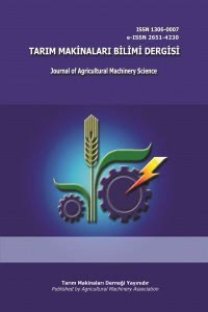Evaluation of Cylinder Rotational Speed for Rice Grain Losses and Broken Grain Ratio
The aim of this study was to determine of the mechanical losses that occurred during threshing and after threshing the processing from the paddy to rice depend on threshed at different cylinder speeds by the combine harvester. Another purpose is to determine the effect of the cylinder rotational speed on grain losses and broken germination. According to results, the effect of cylinder rotational speed of combine harvester has been found significant on the amount of broken grain and germination rate (p<0.01). The broken grain has increased with increase of cylinder rotational speed, the germination rate decreased. While the lowest broken grain rate was 0.912% at 650 rpm, the highest broken grain was obtained at 1050 rpm as 4.100%. However, there has been a gradual decrease in germination rates. While the rate of germination rate at 650 rpm was 95.4%, this ration dropped to 85% at 950 rpm and 78% at 1050 rpm. The cylinder rotational speed selected for threshing significantly affected the head rice yield parameters. The lowest broken grain rate was obtained as 6.876% at 650 rpm, while the highest rate was obtained at 950 rpm as 9.072%. The other side, the highest unbroken rate was achieved as 62.955% at 650 rpm, this rate decreased due to the increase in the number of revolutions. The lowest unbroken ratio of grain was obtained at 1050 rpm as 9.168%. The bran ratio increased from 0.846 percent to 1.774%. The lowest brain rate was achieved as 0.846% at 650 rpm, while the highest rate was achieved at 1.774% at 1050 rpm. Head rice yield decreased slightly as the cylinder speed increased. While this rate was 70.67% at 650 rpm, it was 68.87% at 1050 rpm. A similar situation has been achieved in the amount of husk. While the rate of grains at 650 rpm, which is the lowest, is 29.324%, this ratio has increased slightly. Husk ratio, on the other hand, were changed between 29.32% and 31.30%.
Anahtar Kelimeler:
Rice threshing;, Germination, Breakage, Head rice yield;, milling
___
- Anonymous. 2019. Tarım Gıda ve Hayvancılık Bakanlığı.Tarım İstatistikleri. Andrews, S.B., Siebenmorgen, T.J., Mauromoustakos, A., 1992. Evaluation of the McGill 2 rice miller. Cereal Chemistry 69 (1), 35–43. Asabe Standarts 2008. S358.2: 1:1 Measurement forages. 52nd Edn. American Society of Agricultural Engineers, St Joseph MI. Pınar, Y.,M.A. Beyhan. 1992. Çeltik fabrikalarında çeltiğin pirince işleme kalitesi ve ürün kayıpları. Tarımsal Mekanizasyon 14. Ulusal Kongresi. S:239-246, Samsun. Bond, N., 2004. Rice milling. In: Champagne, E.T. (Ed.), Rice: Chemistry and Technology, third ed. American Association of Cereal Chemists, St. Paul, MN, USA, pp. 283–300. Buggenhout, J., Brijs, K., Celus, I., Delcour, J.A. 2013.The breakage susceptibility of raw and parboiled rice: A review. Journal of Food Engineering, 117 (2013) 304–315. Chinsuwan,W and A.Vejasit. 1991. Comparison of Axial-Flow Peg Tooth and Rasp Bar Cylinders for Threshing Soybean. Proceedings of the Fourteenth ASEAN Seminar on Grain Post Harvest Technology. Manila, Philippines, 5-8 November, 1991. Esgici, R. 2012. GAP Bölgesi Karacadağ yöresinde çeltik tarımının hasat-harman mekanizasyonu. Çukurova Üniversitesi Fen Bilimleri Enstitüsü, Tarım Makinaları Anabilim Dalı, Doktora Tezi. Adana. Esgici, R., Pekitkan, F.G., Sessiz, A. 2019. Correlation between rice stem cutting resistance and cracking force of rice kernel. Volume 28 – No. 4A/2019, pages 3014-3021. Fresenius Environmental Bulletin. Ghaly, A.E. 1985. A Stationary Threshing Machine: Design, Construction and Performance Evaluation. Agricultural Mechanization in Asia, Africa and Latin America. Vol .16(3): 19-30 . Kim, S.Y. and Lee, H. 2012. Effects of quality characteristics on milled rice produced under different milling conditions. J. Korean Soc. Appl. Biol. Chem. (2012) 55, 643−649. Kumar, D. and Kalitai, P. 2017. Reducing postharvest losses during storage of grain crops to strengthen food security in developing countries. Foods 2017, 6, 8; doi:10.3390/foods6010008. Ülger, P. 1982. Buğday Hasat-Harmanında Uygulanan DeğiĢik Mekanizasyon Sistemlerinin Tane Ürün Kayıplarına Etkileri. Hasat Öncesi, Hasat ve Hasat Sonrası Ürün Kayıpları Seminer Bildirileri Kitabı, 13-17 Aralık, Ankara. Ülger, P., E. Güzel, B. KayıĢoğlu, B. Eker, B. Akdemir, Y. Pınar ve Y. Bayhan.1996. Tarım Makinaları Ġlkeleri. Trakya Üniversitesi Tekirdağ Ziraat Fakültesi Ders Kitabı No: 29, Fakülteler Matbaası, Ġstanbul. Pınar, Y. and Beyhan, M.A. 1992. Milling quality and rice losses at paddy factories. 14th National Agricultural Mechanization Congress. Samsun, Turkey. Sarwar, J.G. and A.U. Khan. 1987. Comparative of Rasp-Bar and Wire-Loop Cylinders for Threshing Rice Crop. Agricultural Mechanization in Asia, Africa and Latin America. Vol. 18(2): 37-42 Schluterman, D.A. and Siebenmorgen, T.J. 2007. Relating rough rice moisture content reduction and tempering duration to head rice yield reduction. Trans ASAE 50, 137–42. Sessiz, A. , E. Güzel ve Y. Pınar. 1994. Çeltiğin Biçerdöverle Hasadına Yönelik Bazı Parametrelerin Belirlenmesi. Tarımsal Mekanizasyon 15. Ulusal Kongresi Bildiri Kitabı, Antalya. Sessiz, A. 1998. Parmaklı ve Pervazlı Tip Aksiyal Akışlı Harmanlama Ünitelerinin Tasarımı ve Uygun Prototiplerinin Geliştirilmesi Üzerinde Araştırmalar. T.Ü. Fenbilimleri Enstitüsü. Doktora Tezi Edirne. Yılmaz., D., M.E. Gökduman. 2017. Design and Development of a Threshing System for Some Medicinal and Aromatic Plants. International Congress of the New Approaches and Technologies for Sustainable Development, Isparta, Türkiye, 21 - 24 September 2017, ss.513-514.
- ISSN: 1306-0007
- Başlangıç: 2005
- Yayıncı: Tarım Makinaları Derneği
Sayıdaki Diğer Makaleler
Determination of Cost Components Concerning Combine Harvester Use: A Case of Yozgat Province
Nizamettin ERBAŞ, Selahattin ERAKTAN
Diyarbakır İlinin Tarım Makinaları İmalat Sektöründeki Gelişmelerin Değerlendirilmesi
Evaluation of Cylinder Rotational Speed for Rice Grain Losses and Broken Grain Ratio
Reşat ESGİCİ, Abdullah SESSİZ, Fatih Göksel PEKİTKAN
Gıda Ürünlerinin İzlenebilirliğinde Blok Zinciri Teknolojisinin Kullanımı
Dilara GERDAN, Caner KOÇ, Mustafa VATANDAŞ
Çanakkale İli Çiftçilerinin Hassas Hayvancılık Teknolojisi Kullanım Düzeyinin Belirlenmesi
